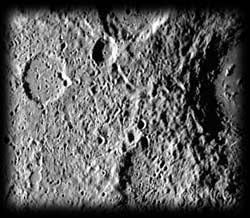 |
|
(Photo: dustbunny) |
Mercury is the closest planet to the Sun and can be considered the younger sibling of Earth, with a diameter less than half that of Earth. Among the nine planets, Mercury ranks second to last. Despite being called Mercury, it has no water whatsoever, making it a completely desolate world. Mercury has no atmosphere, resulting in significant temperature fluctuations between day and night. Due to its proximity to the Sun, daytime temperatures can reach up to 500 degrees Celsius, while at night, the temperature drops rapidly to as low as -170 degrees Celsius, creating a difference of over 600 degrees Celsius between day and night. With such an environment, it is nearly impossible to find any signs of life.
Mercury orbits the Sun very quickly, completing a full orbit in just 88 Earth days. However, its rotation on its axis is quite slow, taking 59 Earth days to complete one full rotation. The rotation direction aligns with its orbit around the Sun, meaning that one full day and night on Mercury lasts much longer than one complete rotation. Calculations indicate that a single day and night on Mercury lasts 176 Earth days, with each period of day and night lasting about 88 days. If we consider Mercury’s orbit around the Sun as its “year,” then one day on Mercury equates to “two years” of its own time.
 |
| Image of Mercury captured by the Mariner 10 spacecraft (Photo: jpl.nasa) |
Because a day and night on Mercury is so long, when observing the Sun from Mercury, it appears to be almost motionless. Moreover, Mercury’s orbit is elliptical (with the closest point to the Sun being 46 million km and the farthest point at 70 million km), and each “day” on Mercury corresponds exactly to one complete orbit. During a day on Mercury, the size of the Sun appears to change dramatically.
From Earth, Mercury appears somewhat reddish; it is dimmer than Venus but still regarded as a bright star in the sky. Its proximity to the Sun often makes it difficult to see due to sunlight glare. On March 16, 1975, the spacecraft Mariner 10 flew just 320 km above Mercury’s surface and captured thousands of images. The photos reveal that Mercury’s surface is covered with circular mountains, plains, valleys, and topographical features very similar to those of the Moon.


















































